Integrated Climate Action Plan (ICAP) for the Island of Hawai'i
Summary
HideIntegrated Climate Action Plan for the Island of Hawaiʻi
Climate change is already impacting the lands and waters on which we live and the health of our communities. The ICAP identifies actions the County government itself can take and is a first step for the County to hold itself accountable for climate action.
Vision and Goals
Vision: We ensure a just transition to a climate resilient island by addressing the causes and impacts of climate change through incorporating equitable climate mitigation and adaptation priorities into policies, programs, infrastructure, and decision-making.
Goals:
-
Increase county capacity to implement climate action.
-
Reduce the County’s contribution to global greenhouse gas emissions.
-
Increase the resilience of County infrastructure, assets, and services to climate change impacts.
Climate Cascade 1
Greenhouse Gas Emissions
This climate cascade establishes a baseline for greenhouse gas emissions for the Island of Hawai‘i from which to develop climate mitigation interventions to reduce Hawai‘i County's contributions to global climate change.
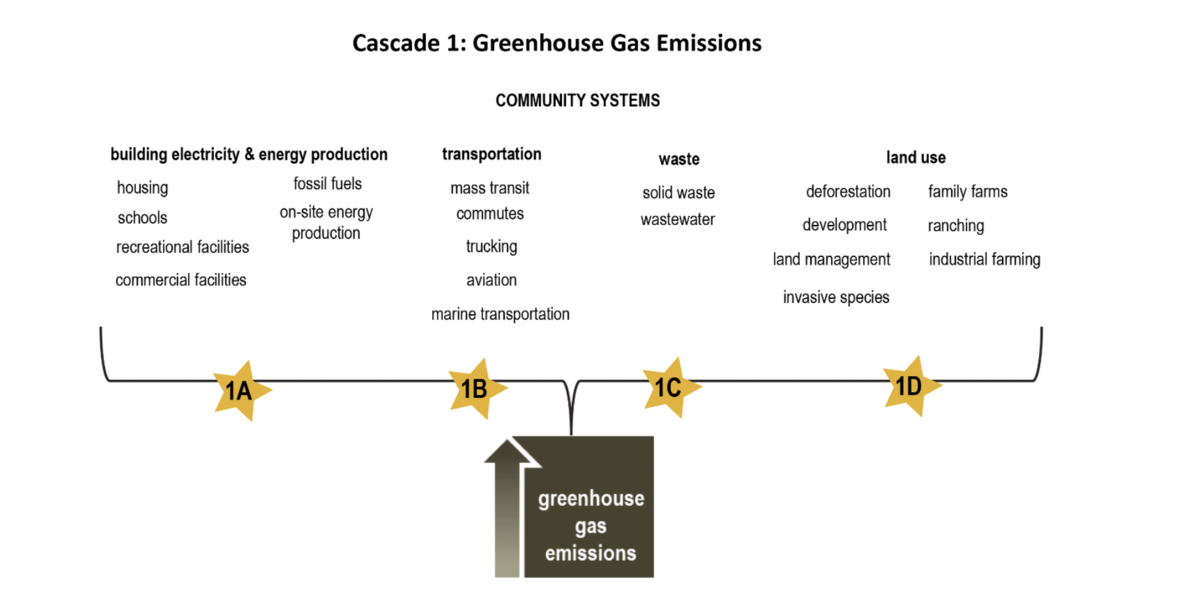
County Intervention Points and Actions
- 1A. Energy & Electricity Use
- Develop energy benchmarking standards for Hawai‘i County buildings
- Transition Hawai‘i County buildings to net zero emissions
-
Implement renewable and energy efficient purchasing policies
-
Inventory greenhouse gas emissions at the municipal and County level
-
Revise building and energy codes to incentivize energy efficiency measures for buildings, electric vehicle (EV) use, low-cost sustainable materials, and LEED standards
-
Support residents and businesses in producing environmentally friendly on-site energy and implementing energy efficient cooling technologies
-
Reduce energy cost of the munipal water supply
-
1B. Transportation
-
Continue implementation of the Multi-Modal Transportation Plan to decrease emissions from individual commutes and decrease emissions of the public transit fleet
-
Transition the County fleet to zero emissions
-
Implement carbon-free vehicle purchasing policies in Hawai‘i County
-
Increase accessibility of zero emissions vehicle infrastructure and alternative transportation options to the public
-
-
1C. Waste
-
Reduce carbon footprint of the landfill
-
Advocate for policies that promote waste diversion through source reduction and recycling
-
Support local businesses and community members in reusing goods and materials
-
Support mulching operations to allow for soil enhancement County-wide
-
Decrease waste of County operations
-
-
1D. Land Use and Carbon Sequestration
-
Establish a system for collecting, monitoring, and evaluating the carbon sequestration potential of Hawai‘i Island and the impact of land use
-
Promote reforestation and conservation of forest canopies, especially in mauka areas that benefit watershed capacity and quality
-
Encourage farming practices that increase soil quality and ability to capture carbon
-
Carbon Credit Programs
-
Climate Cascade 2
Air & Sea Temperature
Air and Sea Surface Temperatures are directly influenced by greenhouse gas emissions. These climate change indicators have direct impacts on human and native ecosystem health.
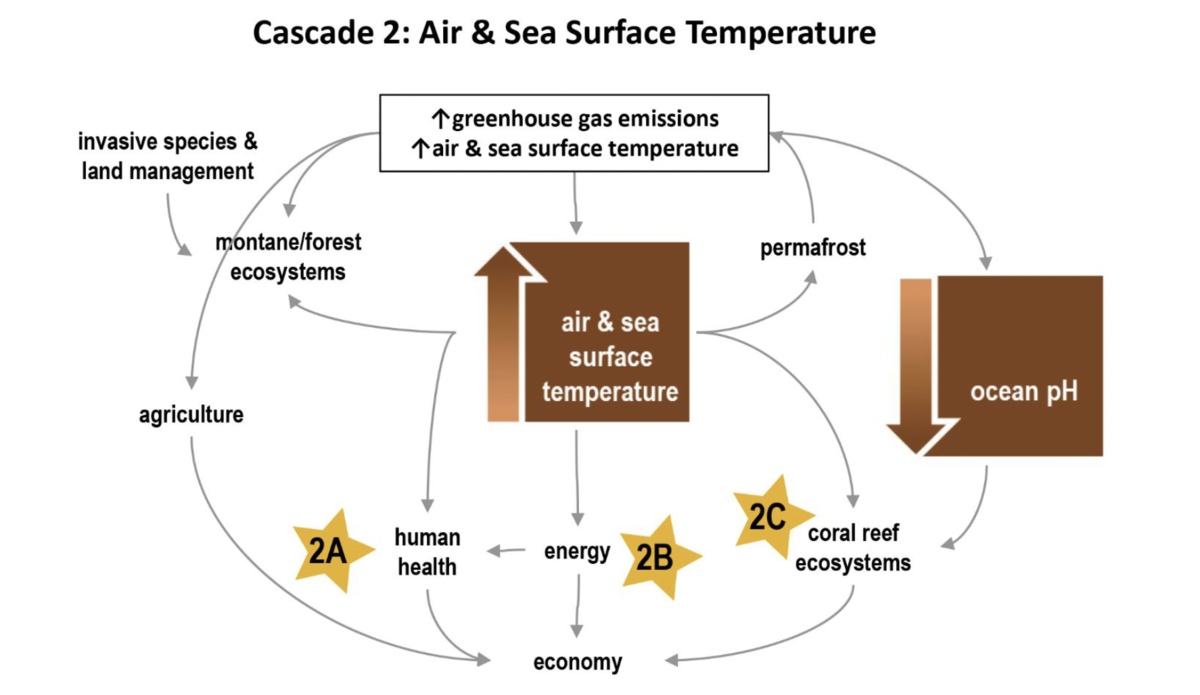
County Intervention Points and Actions
- 2A. Human Health
- Reduce risk to community members participating in events at Parks facilities
- Increase tree canopy in urban areas to reduce the urban heat island effect
- Increase awareness of effects and prevention of heat exposure
- 2B. Energy Resilience
- Ensure County facilities are resilient to increased temperatures
- 2C. Coral Reefs
- Encourage the preservation of coral reefs at County beach parks
- Encourage conversion of cesspools
Climate Cascade 3
Drought & Severe Rainfall Events
Drought and Extreme Rainfall Events are among the climate hazards resulting from increasing air and sea surface temperature and climate variability. Climate hazard exposure to community systems are exacerbated by the compounding hazards of wildfire, landslides, windstorms, and riverine flooding.

County Intervention Points and Actions
- 3A. New Development
- Improve climate hazard risk knowledge
- Update County codes, regulatory standards, and policies to reduce risks from drought, flooding, and fire based on the best available climate projections and observed trends
- Decrease use of pesticides that create toxic runoff
- 3B. Water Resources
- Increase water storage capacity and groundwater recharge
- Reduce water system leakages
- Identify alternative water supplies for times of drought
- Develop a water conservation program
- 3C. Parks and Recreational Areas
- Upgrade/ relocate parks and park facilities exposed to flooding, drought, and other hazards
- 3D. Roads and Bridges
- Upgrade/ relocated roads and bridges vulnerable to flooding from extreme rain events
- 3E. Water and Wastewater Systems
- Upgrade/ relocate wastewater systems exposed to extreme rainfall events
- 3F. Existing Development
- Establish a fire risk reduction program
- Improve stormwater and floodplain management
Climate Cascade 4
Sea Level Rise
Sea Level Rise is a climate hazard with slowly emerging impacts on low-lying community systems, compounded by coastal and riverine flooding and landslides.
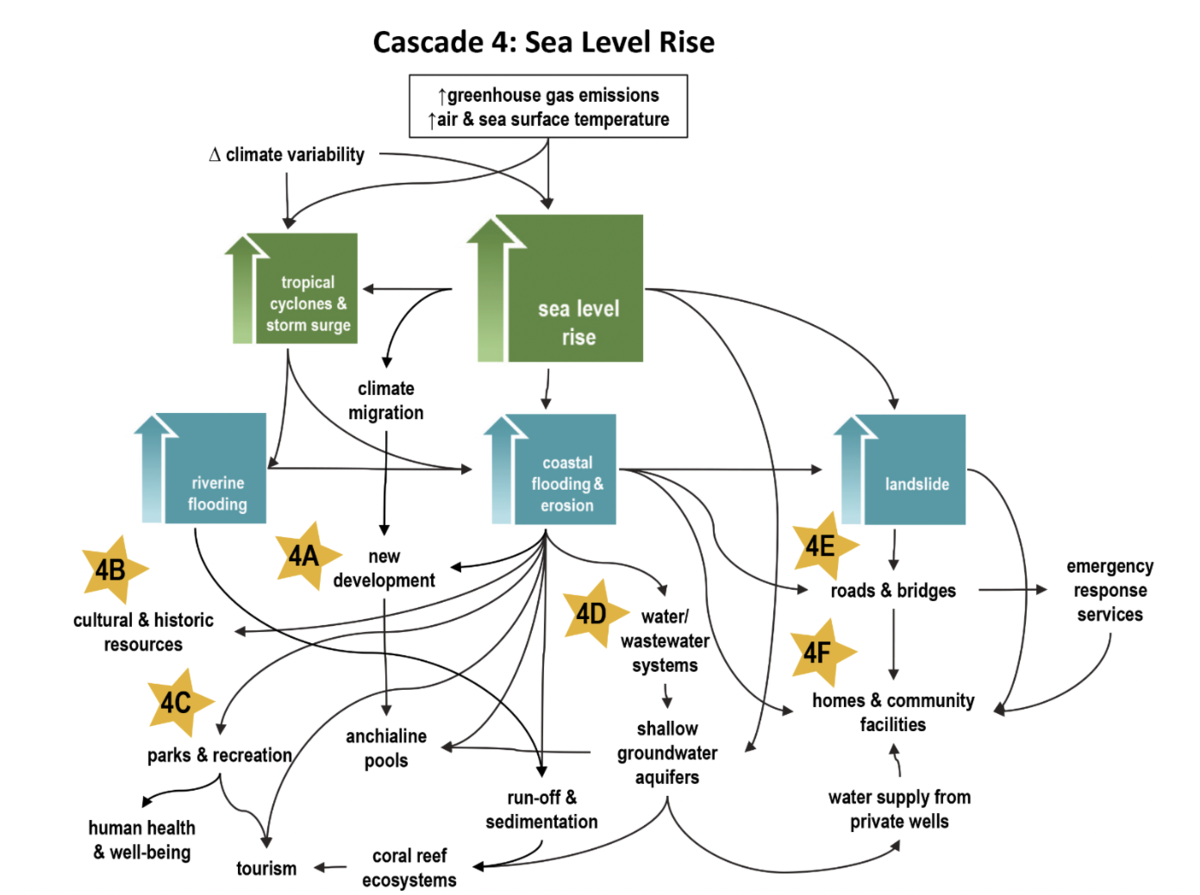
County Intervention Points and Actions
- 4A. New Development
- Improve climate hazard risk knowledge
- Update County codes, regulatory standards, and policies requiring all coastal development to incorporate measures to reduce risk from coastal hazards and sea level rise
- Set aside shoreline areas as open space to benefit natural resources and public access and reduce risk to structures from sea level rise
- 4B. Cultural and Historic Resources
- Assess risks to cultural and historic resources in sea level rise prone areas
- Develop adaptation strategies for cultural and historic resources
- 4C. Parks and Recreational Areas
- Upgrade/ relocate parks and park facilities exposed to sea level rise and other coastal hazards
- 4D. Water and Wastewater Systems
- Upgrade/ relocate water infrastructure exposed to sea level rise
- Upgrade/ relocate wastewater systems exposed to sea level rise
- 4E. Roads and Bridges
- Upgrade/ relocate roads and bridges vulnerable to sea level rise and other coastal hazards
- 4F. Existing Development
- Reduce repetitive flood loss to structures and properties
Climate Cascade 5
Tropical Cyclones and Storm Surge
Tropical Cyclones and Storm Surges are climate hazards with extreme impacts on community systems.
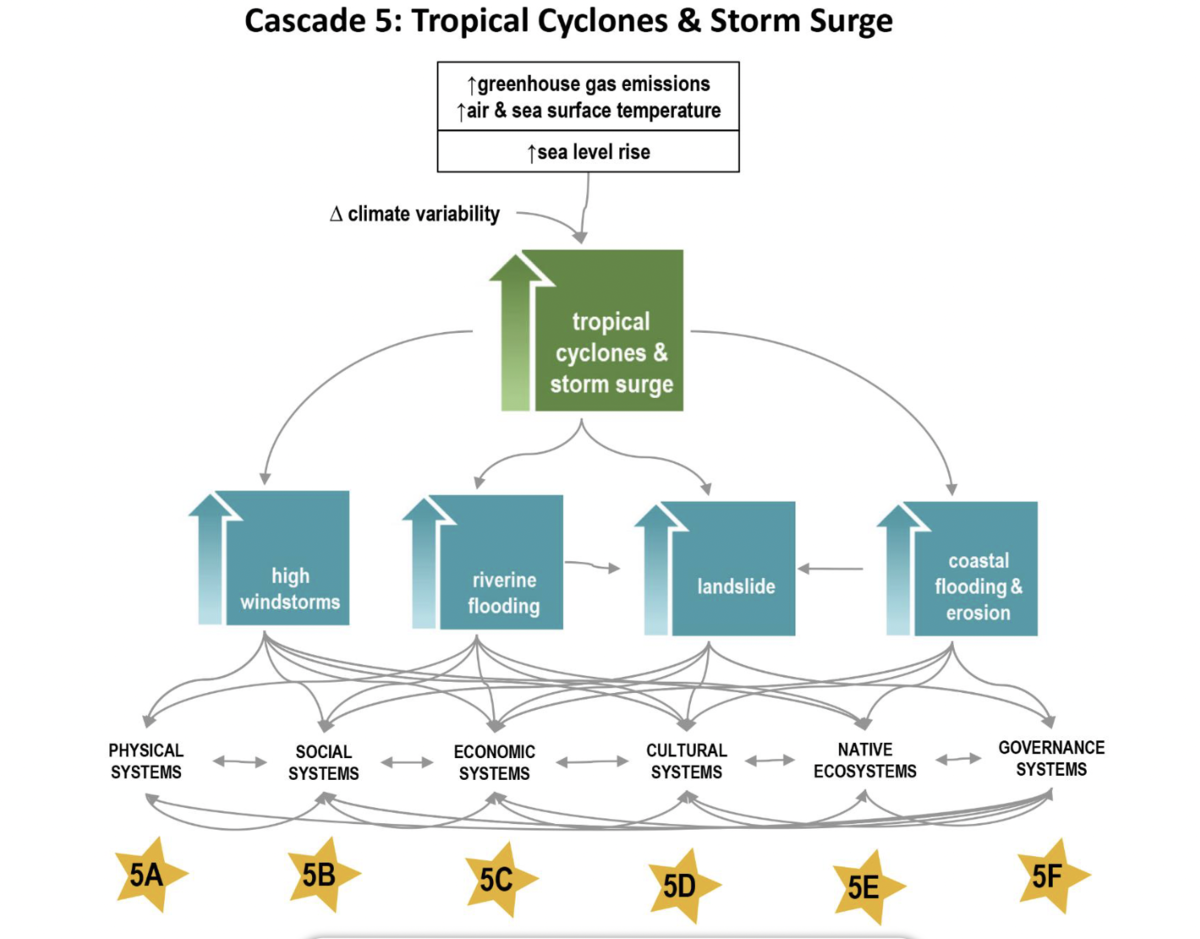
County Intervention Points and Actions
- 5A. Critical Infrastructure
- Upgrade/ harden public safety facilities to remain operational during severe storm event
- 5B. Social Resilience
- Enhance community resilience to withstand and recover from a disaster event
- 5C. Economic Resilience
- Support incentives to enhance economic resilience to withstand a disaster event
- 5D. Cultural and Historic Resources
- Develop cultural resource restoration protocols by ahupuaʻa
- 5E. Hazard Tree Management
- Develop a hazard tree management program to prioritize the removal of trees that pose risks to critical infrastructure from multiple hazards
- 5F. Operational Capacity
- Increase human resource and technological capacity for disaster response
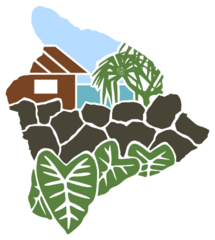
Comments
Close